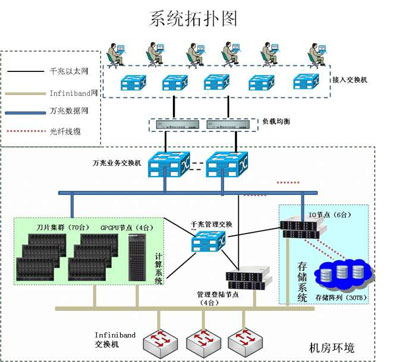
Welcome to Login
微信登录
打开手机微信,扫描二维码

扫描成功
请勿刷新本页面,按手机提示操作

中科曙光不会以任何理由要求您转账汇款,谨防诈骗

您的微信还未注册

中科曙光不会以任何理由要求您转账汇款,谨防诈骗
您可以同时关注中科曙光微信公众号
使用微信扫一扫即可登录! 查阅资料更方便、 快捷!
您已经注册账号和
关注微信公众号

2025年1月
服务热线:400-810-0466

Met-ocean and Environment
From day-to-day weather forecasting to large-scale climate research, from land to sea, from surface hydrometeorology to space weather, Twilight's high-performance computers are active. Sugon's “send” super-calculation system for the National Meteorological Administration represents the super-calculation system. Beginning to lead China's own meteorological research work, while Sugon provides technology, products and solutions for the promotion of "smart weather".
1. Demand Analysis
Numerical forecasting is an initial-value problem of partial differential equation, whose precision is mainly depending upon the perfection degree of the model itself and the precision of the model’s initial value field. Currently the numerical model itself has already been approaching perfection and the model’s errors have been under an effective control, so the precision of the initial field has then become the key factor to influence the accuracy of the forecasting. At the early development stage of numerical forecasting, the utilizable observational data completely stems from the manual observations on ground, ships and air sounding. The most inaccessible regions on the sea and the land in lack of observational data are one of the major sources of errors for numerical forecasting for a long period. The meteorological satellite observation which can date back to 1960s has broken the situation in which the meteorological observation is only limited to the regions found with human activities and brought new opportunities for the improvement of numerical forecasting. Up to date the amount of satellite observation used by numerical forecasting systems of some nations has already exceeded 90% the total amount of data. According to the statistics of major business centers in the world, the contribution done by meteorological satellites to assimilation has also outweighed that of regular meteorological observation of air sounding and ground and become one of the major reasons for the rapid improvement of the quality of numerical forecasting across the globe in reacent decades.
Between the end of 1980s and early 1990s, China has launched her first meteorological satellite and established her global numerical forecasting business. However, it started relatively late in the deep study of satellite data assimilation. Since the beginning of 21st century, unprecedented attention has been paid to the satellite data assimilation. In 2003, the 3D variational assimilation framework of GRAPES, a new-generation numercial forecasting system of China achieved direct assimilation on the ATOVS data of NOAA satellites. The application of Chinese satellite data in numerical forecasting ushered in a new stage. After the launch of FY-3, a new-generation meteorological satellite of China was launched, within a short period the research fellows of satellite and numerical forecasting jointly finished a data assimilation test on the micro-wave temperature and humidity probe of FY-3, which had confirmed its application values in numerical forecasting. For years, Chinese scientists have made internationally influential achievements in AMV product generation of FY-2 static satellites, made new improvements to the areas such as the confirmation of cloud height and quality control, carried out further study in the assimilatio application of AMV data of FY-2 and enhanced their utilization rate in numerical forecasting. These years, the contribution of meteorological satellites to the numerical forecasting of China has witnessed a substantial increase. Taking GRAPES-GFS, a new-generation global forecasting system of China which is under a trial operation by National Meteorological Center as the example, the assimilated satellite data has already occupied around 40% the total amount of data. However, the utilization rate of Chinese satellite data is still on the low side. There’s still a great potential for promoting the assimilation of satellite data and improving the quality of numerical forecasting in China.
Satellite data assimilation poses a surprising demand for computer resources. On one hand, the massive satellite data has posed a super-high demand for the capacity, performance and reliability of the storage system. Satellite data is accumulative. Each time a data volume of TBs is received and the amount keeps accumulating. The data accumulated each year can reach a PB level. The reception, disposal and distribution, etc. of satellite data is a big challenge to the data IO capacity of the whole storage system. Usually the read-write bandwith is required to exceed 5GB/s. On the other hand, the satellite data assimilation has a massive amount of computing, thus requring a high-performance computer capacity at dozens of trillions times per second. And the concurrent computer is required to be configured with a high-performance computing network with high bandwith and low delay. Besides, the business operation of satellite data assimilation has posed a relatively high demand for the reliability and stability of the whole system. Some key nodes need to consider dual or multiple activeness, thus posing a relatively high requirement on the safety, backup, disaster recovery, etc. of the data. Meanwhile, with the rapid development of IT technology, the renewal speed of products is also very fast. Generally, products will be discarded within 3-5 years. Therefore, it’s very important to ensure the advanced nature of the system. Only an advanced system can ensure that the users enjoys a higher return over their IT investments.
2. Solutions
Considering the application demand characteristics of satellite data assimilation, Sugon especially stresses on the advancement, high performance, high reliability, high usability and extendability of the system in providing the solutions. The following picture shows the overal topograph of Sugon solutions of satellite data assimilation. The whole system is composed of assimilation server cluster, service switch, access switch and load equalizer. Among them, the assimilation server cluster is the major part of the whole system, which is composed of computing system, network system, storage system, management system and software system.

The computing system of assimilation server cluster adopts a CPU+GPU heterrogenous architecture. The CPU node adopts Sugon’s new-generation two-way computing blades, equipped with the currently newest x86 processor. While the GPU node adopts Sugon rack-mounted high-performance workstations. Each workstation provides at most four newest GPGPU computer cards, which provides the industry-leading super-high computing density. The peak value of the dual precision floating-point computation of the system can reach tens of trillions or hundreds of trillions of times, which can fully satisfy the demand of satellite data assimilation for computing capacity. The computing network adopts Infiniband high-speed network with a full line speed, with the highest one-way bandwith reaching 56Gb/s, the delay less than 1μs, which can effectively reduce the communciation bottleneck between each node of the cluster. The storage system is equipped with Parastor100 concurrent file system which is rolled out by Sugon especially for high-performance computation. In hardware, a redundant SAN architecutre is adopted, which is equipped with big-capacity high-end disk array. Through a multiple of IO nodes, it achieves a large-scale concurrent read-write of the data, with the IO bandwidth of the storage system exceeding 5GB/s. Besides, in the design of HPC cluster, adequate attention has been paid to the redundancy of key nodes and key parts. The whole system is relatively reliable and stable, to fully ensure the normal completion of the satellite data assimilation.
Dawning Information Industry Co.,Ltd. Sugon Building, No.36 Zhongguancun Software Park, No.8 Dongbeiwang West Road, Haidian District, Beijing 100193
Tel:+86 400-810-0466
Fax:+86 10-56308222
E-mail:international@sugon.com
Dawning Information Industry Co.,Ltd. Sugon Building, No.36 Zhongguancun Software Park, No.8 Dongbeiwang West Road, Haidian District, Beijing 100193
Tel:+86 400-810-0466
Fax:+86 10-56308222
E-mail:international@sugon.com



 Register /
Register /